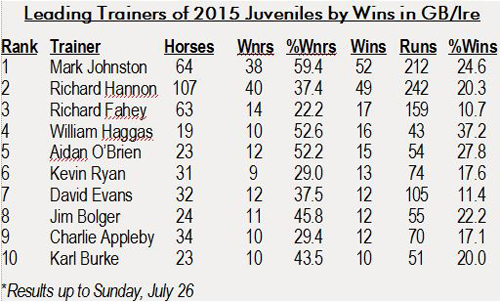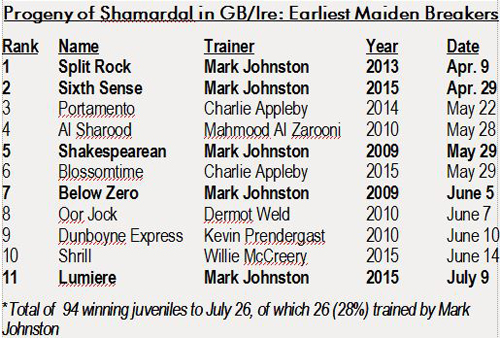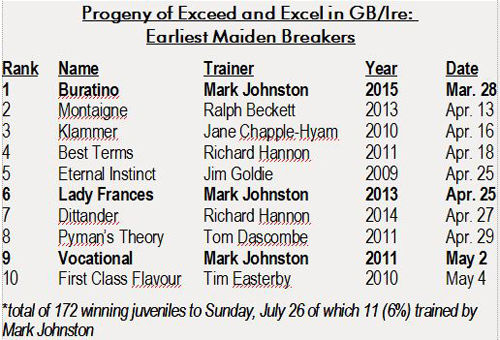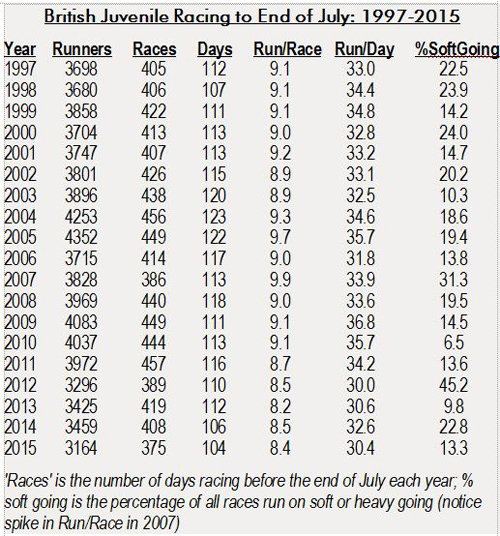In the second part of this review (click here for part one) we will concentrate on trainers, rather than horses, expanding on the remarkable statistics of North Yorkshire-based Mark Johnston referred to last time that have generated some interest.
Johnston has 140 juveniles listed as in training, according to the relevant section of his website (click here). He has run just 64 of these, 43 fewer than his closest rival in this division, Richard Hannon. Johnston is the leading trainer in Britain and Ireland by wins, and of the top three in this category delineated in the table, he also has the highest winners-to-runners (59.4%) and percentage strike-rate (24.6%).
The vast majority of Johnston's juveniles are owned by the Maktoum family. Of his runners so far, six are by Shamardal, six by Cape Cross (Ire), five by Poet's Voice (GB), four by both Exceed And Excel (Aus) and Lonhro (Aus), while 31 other sires make up the 64 individuals.
Johnston is an iconoclast among trainers. A qualified vet, he is process-driven and extremely analytical, determining the best course of action from within his own instincts and intelligence rather than mainly by received wisdom, as is the tradition in racing around the world. Horses with the type of pedigree Johnston has to train are normally campaigned rather conservatively as juveniles. Take those by the sire Shamardal, for instance, a Johnston favorite whom he trained as a 2-year-old to win the 2004 G1 Dewhurst S. at Newmarket in October (Shamardal, who is from the family of Street Cry {Ire}, trained on well when transferred to Godolphin and won a further three Group 1 races as a 3-year-old). The Darley standout has sired 94 winning juveniles in Britain and Ireland, and the distribution of the date of their first win is described in the chart:
The shape of this graph is common among the better European sires. It is more negatively skewed (a longer left-hand tail) than a normal, bell-curve distribution with the most common months being August, September and October. If we examine the horses that make up the extreme left tail of Shamardal's distribution, an interesting pattern emerges. The table lists the 10 sons or daughters of the stallion to get off the mark earliest in their juvenile campaigns:
Johnston has trained only 26 of the 94 winning juveniles by Shamardal, yet four of the 10 earliest scorers–and the three of the top five–were housed at his Kingsley Park. Sixth Sense (Ire) is a notable example of the Johnston belief in training horses, not pedigrees, for he is a late foal out of a Sadler's Wells mare, yet made his debut on Apr. 3 and recently won a listed race over seven furlongs at Ascot on his seventh start.
Lumiere (GB), the wildly impressive Newmarket maiden winner featured in the first part, is the 19th fastest of 94 by her sire off the mark, and it is reasonable to think she may not have been seen yet in other hands. Yet, before she had even appeared, Johnston's best horse, Buratino (Ire) (Exceed and Excel {Aus}) had run six times, culminating in victory in the G2 Coventry S. at Ascot. Buratino's sire, Exceed And Excel, has a different distribution of maiden breakers, as the following bar chart displays:
Exceed And Excel's chart is typical of the commercial sires in Europe. In contrast to that of Shamardal, it is positively skewed (a longer right tail) with the most common months to see an Exceed And Excel break its duck being May, June and July. Yet, even by the sire's standards, Buratino proved one precocious dude, as the table of earliest maiden breakers shows:
Johnston has trained just 11 of Exceed And Excel's 172 winning juveniles in Britain and Ireland, yet half of them are among the 10 fastest off the mark. And Buratino tops the chart. According to Racing Post Ratings, a widely used measure of racehorse merit, Buratino showed progressive form up to his June 16 triumph, registering figures of 85-81-93-89-108-113. (Note that Sixth Sense's array is 75-83-85-88-99-94-99, while that of useful filly Muhadathat is 73-76-86-87-92.)
It clearly isn't hurting these horses to actually race for the public's enjoyment. Johnston says he prefers to gallop his horses for money than behind closed doors, and while he has been able to select (or his horses have self-selected by the precocity shown at home) the earliest types from a large pool of talent, it is clearly a big advantage to be aggressive given the following trends:
In parallel with British racing at all age-levels, juvenile runners-per-race and runners-per-day metrics to the end of July show a persistent downward trend. In the 19 seasons with 1997 and 2015 as endpoints, the five lowest runners-per-race years are the five most recent, while the other important metric runners-per-day shows a similar pattern.
Johnston's success is partly a function of paying attention to classic portfolio management. With a large number of horses in his care, he needs to campaign a fair proportion early in order to diversify the career trajectories of his string and thereby optimize the performance of the whole. Any trainer in his position not doing the same would be making an error in terms of maximizing the prize money and group race-winning expectation of his stable strength. Remember, Johnston has 77 other 2-year-olds on the roster who haven't even made their debut.
Of course, the theory is comparatively easy to expound, but it requires a rare individual and a super-efficient staff to bring it to realization at the level that Johnston is doing.
Data via Proform (www.proformracing.com).
Not a subscriber? Click here to sign up for the daily PDF or alerts.












